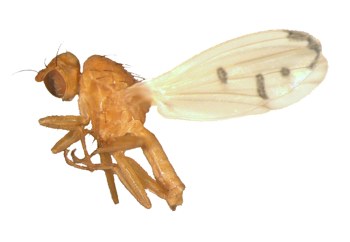Pests
Opomyza florum Fabricius - Yellow Cereal Fly, Grass Fly.
Systematic position.
Class Insecta, order Diptera, family Opomyzidae, genus Opomyza.Biological group.
Oligophagous cereal pests.Morphology and biology.
Imago 3.5-4 mm, with rusty-yellow coloration. Wings oval, transparent, yellowish, with smoky-brown spots around cross-vein and at apices of longitudinal veins. Mesonotum with several rows of dark setae and with 4 setae on scutellum. Abdomen thin, pointed at the end in females, oval in males. Females are in imaginal diapause until autumn, having underdeveloped ovaries. Egg elongate-oval, somewhat narrowed on one side. Chorion covered with longitudinal deep foveae. Larvae appear in early spring and penetrate into shoots, make holes, rise upward along the rolled leaf tube or pass to lateral tillers. Larvae have thick fleshy processes on the body end. Mandibles anteriorly lean on chitinous semi-ring. Damage caused by Opomyza is similar to damage caused by Oscinella frit and Delia coarctata; the central leaf of a stalk and then the whole stalk turns yellow and withers. Puparium brown, with 2 blunt processes posteriorly, and with 4 denticles anteriorly. Eggs winter on winter cereals in the upper soil layer.Distribution.
Occurs in all of Europe including the Ukraine. In Russia it is widely distributed in the European part, north-westward to the Leningrad Region, north-eastward to the Perm Region, eastward to Bashkiria, south-eastward to the Stavropol Territory and republics of the Northern Caucasus. Ecological and biological characteristics of the species make it unable to inhabit some areas of Transcaucasia, Southern Siberia (to Krasnoyarsk) and Kazakhstan (to Almaty); however special investigations on its presence in these regions have not been carried out.Ecology.
Monovoltine. The start of the imago spring flight at the end of May - June occurs depending on agroclimatic zones. Females feed on wild cereals, and also on leguminous and cereal grasses the entire summer. In September - October, the imagoes migrate to winter wheat crops, mating and laying eggs in soil near plants at a depth to 3 cm. The factor limiting spread of the fly is air temperatures above 22°C, and precipitation less than 90 mm. Optimal relative air humidity for puparia development is 60 to 100%.Economic significance.
The greatest damage is to winter cereals such as wheat, rye, and barley. Reproduces also on wild-growing cereals of the genera Poa, Agropyron, Phleum, Lolium, Agrostis. Unlike the Frit Fly, the Yellow Cereal Fly causes harm in early spring only; unlike the Wheat Bulb Fly, it never damages tillering nodes. Control measures include pre-sowing, seed dressing and optimum time of sowing.Reference citations:
Belyaev I.M. 1974. Pests of grain crops. Moscow: Kolos. 284 p. (In Russian)Narchuk E.P. 1981. Opomyzidae. In: Narchuk E.P, Tryapitsyn V.A., editors. Insects and mites-pests of agricultural plants. V. 4. Hymenoptera and Diptera. Leningrad: Nauka. 155-156 p. (In Russian)
Pavlyuchuk I.V. 1969. Opomyza is a winter cereal pest. Zashchita rastenii, 11: 24-25. (In Russian)
Pavlyuchuk I.V. 1970. To biology and ecology of a winter cereal pest Opomyza florum F. in the Stavropol Territory. In: Plant protection and chemistry in agriculture. Proceedings of Stavropol SKHI, 33(2): 11-15. (In Russian)
Pavlyuchuk I.V. 1972. Biological basis of Opomyza florum Fabr. distribution in the Stavropol Territory. In: Plant protection and chemistry in agriculture. Proceedings of Stavropol SKHI, 35(3): 46-50. (In Russian)
Pavlyuchuk I.V. 1974. Harmfulness of Opomyza florum Fabr. and influencing agricultural methods. In: Plant protection and chemistry in agriculture. Proceedings of Stavropol SKHI, 37(3): 10-15. (In Russian)
Rogochaya E.G. 1974. Opomyzidae. In: Vasil.ev V.P., editor. Pests of agricultural crops and forest plantations. Kiev: Urozhai. V. 2: 533-534. (In Russian)
Shchegolev V.N., Znamenskii A.V., Bei-Bienko G.YA. 1934. Insect pests on field crops. Leningrad & Moscow: Sel.khozgiz. 364 pp. (In Russian)
Vilkova N.A. 1963. Opomyza is a cereal pest. Zashchita rastenii, 9: 53. (In Russian)
Zagovora A.V., Kravchenko A.B., Budennaya K.I. 1981. Opomyza on wheat. Zashchita rastenii, 10: 44-45. (In Russian)


